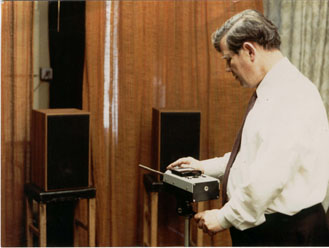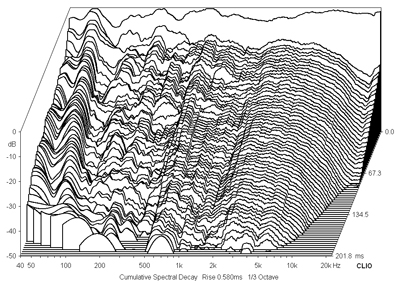You are using an out of date browser. It may not display this or other websites correctly.
You should upgrade or use an alternative browser.
You should upgrade or use an alternative browser.
Ported or sealed box speakers. Which do you prefer?
- Thread starter lindsayt
- Start date
linnfomaniac83
I bet you can’t wheelie a unicycle!
Welcome to hear Ninkas if you’re near me!I've voted ported as I've never owned sealed boxes, maybe someone will tell me what I've been missing out on all this time
tuga
Legal Alien
Not really. The approach was intended to design speaker cabinets that are relatively light in weight, modest in cost, straightforward to build using the modest materials and technology available 50 years ago and that are just good enough to do the job. The cabinets have resonances at unusually low frequencies that are relatively poorly damped but at frequencies where the ear is relatively insensitive to the sound of resonances. The upside is that this enables relatively poorly performing extensional damping to be more effective at the higher midrange frequencies where the ear is more sensitive to resonances. It was a good sensible pragmatic approach 50 years ago for speaker cabinets that were intended to be easy to make, modest cost, large but light enough to be lugged around.
No competent engineer would follow this approach for a high technical performance speaker today (nor would they have done 50 years ago if a significantly more complex, costly and heavier approach was an option). But quite a few competent people from sales might.
You are right about design and budget constraints, and Sphile's measurements show some strong cabinet resonances particular in the larger models at around 100-200Hz which are overall somewhat noisy in the lower- and sub-bass region.
But to be fair the paper was published in '77. I don't think that BnW had come up with Matrix yet, and most hi-fi manufacturers where still building cabinets with little or no internal bracing.
mandryka
pfm Member
I’d never expect a small driver speaker to fill a large space.
This is very good advice which completely matches my own experience.
Joe P
Memory Alpha incarnate | mod; Shatner number = 2
Keith,
The Cessaros are sealed? Wouldn’t they be considered horn-loaded?
Joe
All active sealed here,
The Cessaros are sealed? Wouldn’t they be considered horn-loaded?
Joe
The advice doesn't make much sense to me (and I would be cautious of advice that says "do this" rather than "do this because"). Depending on the design a stand might aid or hinder the transmission of energy from a vibrating speaker into the floor. Supergluing a vibrating speaker to a ten lump of concrete for a stand might inhibit the cabinet motion a bit but it won't stop it.When I bought some Spendor SP1s I rang Spendor and discussed stands. They advised me to make sure that I placed them on stands which would allow the cabs to vibrate. Any thoughts about why?
Mike Reed
pfm Member
If you went and demoed the Naim 72 250 back in the day the most likely speaker to be used by the dealership would be SBLs which are sealed box It all depends what you compare it with.
I had Briks with this combo, then went to 82/135s (with Briks). Borrowed SBLs for a time when I had 52 (I think) and 135s. Very nice for their size but a cool, rather unemotional presentation. The ProAc Response Threes came directly after; chalk and cheese, which is why I went up the ProAc R ladder (to Fours !)
Darren L
Egalitarian
Welcome to hear Ninkas if you’re near me!
Thanks for the kind offer.
I was not criticising the BBC work which appeared to be very good in serving their objectives. Not aware of anything like it since. I was simply pointing out that what the BBC wanted to achieve was not a high performance speaker cabinet in the sense of being as inert as possible.But to be fair the paper was published in '77.
The B&W matrix is not ideal in the sense it appears overly complicated for what is required but over-engineering is often a positive attribute when it comes to luxury products. This tends to be true of some of the other B&W speaker features as well. Others look like good engineering but some like the tweeter/midrange arrangement seem odd. Would be interesting to know the thinking and history behind the current speaker configurations.I don't think that BnW had come up with Matrix yet, and most hi-fi manufacturers where still building cabinets with little or no internal bracing.
tuga
Legal Alien
I was not criticising the BBC work which appeared to be very good in serving their objectives. Not aware of anything like it since. I was simply pointing out that what the BBC wanted to achieve was not a high performance speaker cabinet in the sense of being as inert as possible.
The B&W matrix is not ideal in the sense it appears overly complicated for what is required but over-engineering is often a positive attribute when it comes to luxury products. This tends to be true of some of the other B&W speaker features as well. Others look like good engineering but some like the tweeter/midrange arrangement seem odd. Would be interesting to know the thinking and history behind the current speaker configurations.
Elipson looks like an interesting case study
mandryka
pfm Member
The advice doesn't make much sense to me (and I would be cautious of advice that says "do this" rather than "do this because"). Depending on the design a stand might aid or hinder the transmission of energy from a vibrating speaker into the floor. Supergluing a vibrating speaker to a ten lump of concrete for a stand might inhibit the cabinet motion a bit but it won't stop it.
What he said (I made a note) was that the that the speakers are “thin walled”, and are hence designed to vibrate and resonate with the music.
tuga
Legal Alien
What he said (I made a note) was that the that the speakers are “thin walled”, and are hence designed to vibrate and resonate with the music.
I think that the idea of the damped thin-wall cabinet is to let all pannels but the baffle vibrate in a controlled manner at a frequency that is less harmful to the music programme.
Perhaps the goal of a wooden stool/stand is to produce a similar effect. I am using wooden stools for other reasons (budget constraints).

Maurice E. Whatton measuring the LS3/5a (source)
Tony L
Administrator
I’m positive there is an advantage in being light/low mass with the BBC cabinet designs too whether it was intentional at the time or not. Certainly really heavy massy MDF cabs tend to sound very odd to me (Focal, Usher etc etc). Give me a BC1 or LS3/5A any day!
PS I suspect it is a factor in JR149s being so crazy good too; they are very low mass, yet non-resonant.
PS I suspect it is a factor in JR149s being so crazy good too; they are very low mass, yet non-resonant.
tuga
Legal Alien
I’m positive there is an advantage in being light/low mass with the BBC cabinet designs too whether it was intentional at the time or not. Certainly really heavy massy MDF cabs tend to sound very odd to me (Focal, Usher etc etc). Give me a BC1 or LS3/5A any day!
PS I suspect it is a factor in JR149s being so crazy good too; they are very low mass, yet non-resonant.
I suspect that Focal, Usher, etc. probably sound bad because of driver resonances.
The Graham LS5/9s produce very clean midrage and treble decay:


Here is the original BBC paper on the design of the LS3/5A, it’s interesting reading (if you are interested in reading that kind of thing)
http://downloads.bbc.co.uk/rd/pubs/reports/1976-29.pdf
The reason they give for the damping is ..
“The use of any type of hard wood such as Parana Pine for the fillets was found to be unacceptable as a clearly audible colouration was produced by a resonance of the l.f. unit on its chassis, and these fillets had insufficient mechanical impedance to reduce it.. In order to ensure that this resonance would not give rise to any further difficulties the side panels are damped with a layer of damping material and the top and bottom panels with two layers.”
It is also interesting how they measured stereo accuracy using speech.
btw, as far as the original question is concerned, small BBC like the LS3/5A weren’t ported, larger ones were.
http://downloads.bbc.co.uk/rd/pubs/reports/1976-29.pdf
The reason they give for the damping is ..
“The use of any type of hard wood such as Parana Pine for the fillets was found to be unacceptable as a clearly audible colouration was produced by a resonance of the l.f. unit on its chassis, and these fillets had insufficient mechanical impedance to reduce it.. In order to ensure that this resonance would not give rise to any further difficulties the side panels are damped with a layer of damping material and the top and bottom panels with two layers.”
It is also interesting how they measured stereo accuracy using speech.
btw, as far as the original question is concerned, small BBC like the LS3/5A weren’t ported, larger ones were.
tuga
Legal Alien
Here is the original BBC paper on the design of the LS3/5A, it’s interesting reading (if you are interested in reading that kind of thing)
http://downloads.bbc.co.uk/rd/pubs/reports/1976-29.pdf
The reason they give for the damping is ..
“The use of any type of hard wood such as Parana Pine for the fillets was found to be unacceptable as a clearly audible colouration was produced by a resonance of the l.f. unit on its chassis, and these fillets had insufficient mechanical impedance to reduce it.. In order to ensure that this resonance would not give rise to any further difficulties the side panels are damped with a layer of damping material and the top and bottom panels with two layers.”
It is also interesting how they measured stereo accuracy using speech.
btw, as far as the original question is concerned, small BBC like the LS3/5A weren’t ported, larger ones were.
The problem with the LS3/5as (and similar mini-speakers) is that they aren't really suited for serious listening unless supported by subs.



